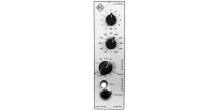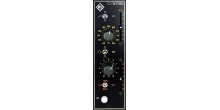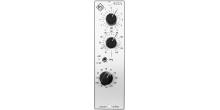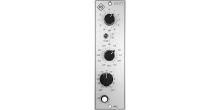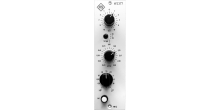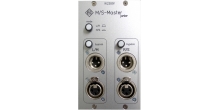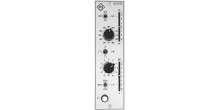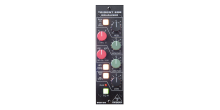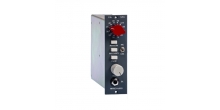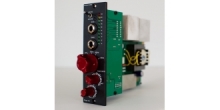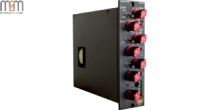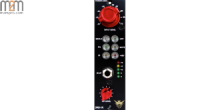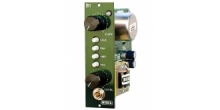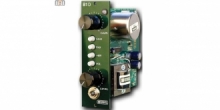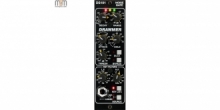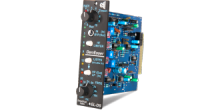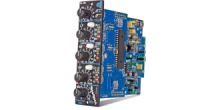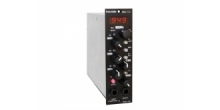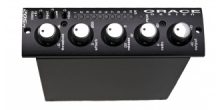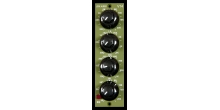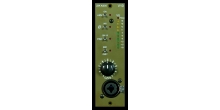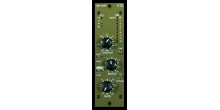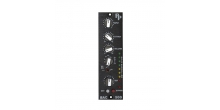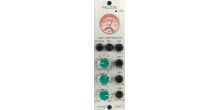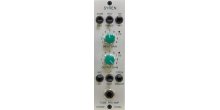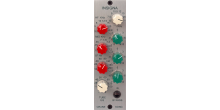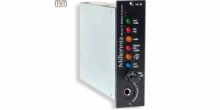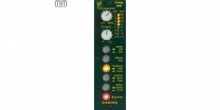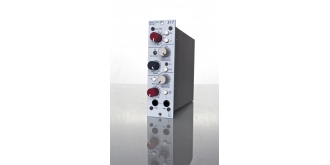 Agrandir l'image
Agrandir l'image
| Gain Range: | Continuously variable from 6 dB to +20 dB. |
| Threshold Range: | Continuously variable from 36 dB to +22 dB. |
| Ratio Range: | Continuously variable from 1.1:1 to Limit (40:1). |
| Attack Range: | Continuously variable from 20mS to 75mS |
| Release Range: | Continuously variable from 100mS to 2.5 Seconds. |
| FF/FB: | Feed-Forward or Feed-Back VCA control. |
| Maximum Output Level: | Balanced and Floating Transformer Output Maximum output from 20 Hz to 40 kHz is +23 dBu. |
| Total Harmonic Distortion and Noise: | @ 1kHz, +20 dBu output level, no load. Main Output, compressor bypassed Better than 0.0006%. Main Output, compressor engaged Better than 0.02% |
| Noise: | Measured at Main Output, un-weighted, 22Hz-22kHz, Terminated 40 Ohms. With Gain at Unity, Compressor disengaged Better than 103 dBu. With Gain at Unity, Compressor engaged: Better than 92 dBu |
| Frequency Response: | Main Output, Unity Gain @ 18 Hz, +/- .1dB @ 150 kHz -3 dB. |
| Crosstalk | Measured Channel to Channel: Better than 90 dB @ 15kHz. |
| METERS: | Monitor INPUT LEVEL and GAIN REDUCTION |
RUPERT700X
Nouveau
RUPERT NEVE - 517

Based on the Portico 5017 Mobile Pre, the 517 provides world-class transformer-coupled micpreamp, compressor and DI circuitry with Vari-phase, "Silk" and DI/mic blending capabilities - all in a single 500 series module.
Mic Pre and Instrument Amplifier
The 517's mic pre - based on the TEC Award-winning Portico 5017 - provides up to 66dB of gain, polarity-reverse and phantom power switches, and the "Silk" circuit for a more vintage vibe. The separate instrument amplifier includes 30dB of gain, a ground lift, variable phase and an instrument Thru connection.
Blended Use
Used as a single channel device for instruments, the 517 can be used to phase align, combine and compress direct and amplified signals. To achieve this, use the DI for the instrument's direct signal and the mic preamp for the speaker cabinet signal. The blend control is used for mixing direct and amplified signals to achieve the desired tonal blend between the two sources, and the variphase is used to minimize or extenuate phase cancellations between the two signals. To compress the blended signal, the internal compressor jumper must be set to the blend path (this is the default setting). This technique could also be used to create a single, mixed output of a guitar and vocals.
The Compressor
Based around a new LDR (light dependent resister) design, the 517's opto-coupler compressor has been simplified to a single threshold control with auto make up gain. By default, the compressor is set to a fixed 2:1 ratio with fixed attack and release. To set the compressor, simply dial the threshold control down until the desired amount of compression is achieved. An LED light indicates when the compressor is active.
Vari-Phase
In addition to the standard polarity reverse, the 517's vari-phase control may be used to adjust phase incrementally. This control is useful any time two signals derived from the same source are combined.
For instance, even with careful placement, the combination of close miced drums and overheads, can often yield hollow-sounding results. By using the variable phase adjust, the direct signal can be phase rotated until the signals are naturally aligned.
This technique is also extremely useful when combined with the internal blend control on instruments. A bassist or guitarist using both direct and mic'd signals can blend the two into a single output, using the variable phase to reach an optimal alignment. By adjusting the phase in the 517, the musician or engineer can find the absolute best mic position without regard to the phase relation to the direct signal.
Features
Compression
For signals below the "threshold" level that has been set, a compressor provides a linear path allowing signals to be amplified without the gain being adjusted in any way. When signals exceed the "threshold" level, the gain is reduced in a controlled manner that depends on the Ratio that has been set.
Gain
GAIN range provided is from -6dB to +20 dB. As already noted, when compression has taken place, it may be necessary to increase the overall gain to restore the apparent program level
Peak
When engaged, the 543 uses a combination of peak and RMS (average) detection to determine level. When disengaged, it follows just RMS.
SC HPF
Introduces a HPF at 250Hz to the VCA side chain signal. This allows the compressor to disregard sustained low frequency content.
Ratio
Range from 1:1 to LIMIT (i.e. 40:1)
Threshold
Range from -30dBu to +20dBU
Attack Time
Range from 20 mS to 75 mS.
Release / Recovery Time
Range of RELEASE time is 100 mS to 2.5 Seconds.
Stereo Operation
When the LINK switch is engaged on two 543 modules and settings are approximately the same values, GAIN reduction on both channels will be the same to preserve stereo balance and position. This will work properly in link buss enabled 500 series racks, or by hardwiring two 543 modules link busses together in non-compatible racks.
Ducking
When the LINK switch is engaged on two connected 543 modules, the signal passing through the first module may be used to control the amplitude of a second module. For example, the level of music through channel A can be controlled by speech on channel B, i.e. reducing the music level to make a "speech-over" announcement.
Meters
Two Peak LED METERS are provided that show OUTPUT LEVEL and GAIN REDUCTION.
Output level meter covers the range from -10 to +22 dBu and above which is regarded as overload.
REDUCTION is calibrated in dB covering the range +1 to 22 dBu, reading from right to left,
Features And Specs
| Gain Range: | Continuously variable from 6 dB to +20 dB. |
| Threshold Range: | Continuously variable from 36 dB to +22 dB. |
| Ratio Range: | Continuously variable from 1.1:1 to Limit (40:1). |
| Attack Range: | Continuously variable from 20mS to 75mS |
| Release Range: | Continuously variable from 100mS to 2.5 Seconds. |
| FF/FB: | Feed-Forward or Feed-Back VCA control. |
| Maximum Output Level: | Balanced and Floating Transformer Output Maximum output from 20 Hz to 40 kHz is +23 dBu. |
| Total Harmonic Distortion and Noise: | @ 1kHz, +20 dBu output level, no load. Main Output, compressor bypassed Better than 0.0006%. Main Output, compressor engaged Better than 0.02% |
| Noise: | Measured at Main Output, un-weighted, 22Hz-22kHz, Terminated 40 Ohms. With Gain at Unity, Compressor disengaged Better than 103 dBu. With Gain at Unity, Compressor engaged: Better than 92 dBu |
| Frequency Response: | Main Output, Unity Gain @ 18 Hz, +/- .1dB @ 150 kHz -3 dB. |
| Crosstalk | Measured Channel to Channel: Better than 90 dB @ 15kHz. |
| METERS: | Monitor INPUT LEVEL and GAIN REDUCTION |
| Type de matériel | Préamplis |




